Key takeaways:
- Jazz standards evoke deep emotional connections and collective experiences, serving as a reflection of cultural contexts and societal issues.
- Key elements of jazz analysis include rhythm, harmony, melody, and improvisation, each contributing to the music’s richness and unpredictability.
- Applying analytical insights to performance enhances creativity and emotional expression, transforming familiar pieces into unique experiences on stage.
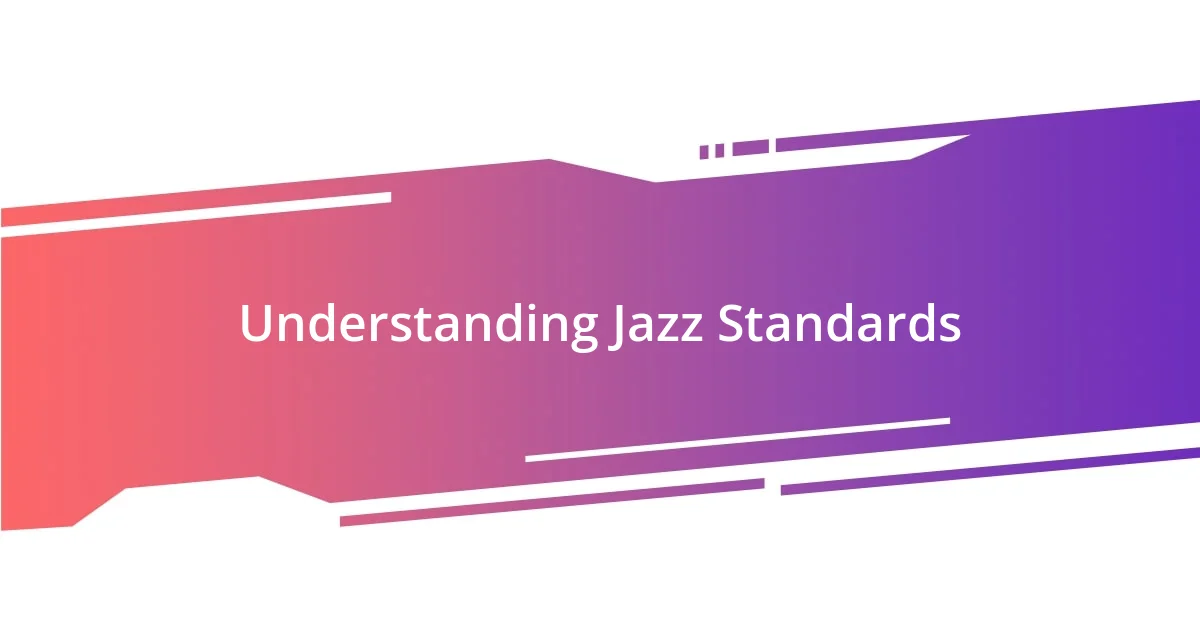
Understanding Jazz Standards
Jazz standards serve as the backbone of jazz music, often embodying timeless melodies and complex harmonies that invite personal interpretation. I still remember the first time I played “Autumn Leaves” with a group; the way the minor and major shifts combined created a world of emotion that I couldn’t fully articulate. How can a mere set of chord changes evoke such deep feelings?
These compositions often hold a special significance, transcending individual performances to become shared experiences between musicians and audiences. I think back to jamming on “Blue Bossa” with fellow musicians late into a summer night—we were all there, in that moment, united by the language of jazz. Isn’t it fascinating how songs can carry collective memories and emotions, allowing us to connect in ways words often fail to express?
Understanding jazz standards also means delving into their cultural contexts—their stories and the eras from which they emerged. With each standard, I’m reminded of how composers like Duke Ellington and Ella Fitzgerald not only shaped the genre but also offered a mirror to society. What lessons do these songs impart about love, struggle, and resilience? Each note played can open up a dialogue, prompting us to explore not just the music, but the world around us.
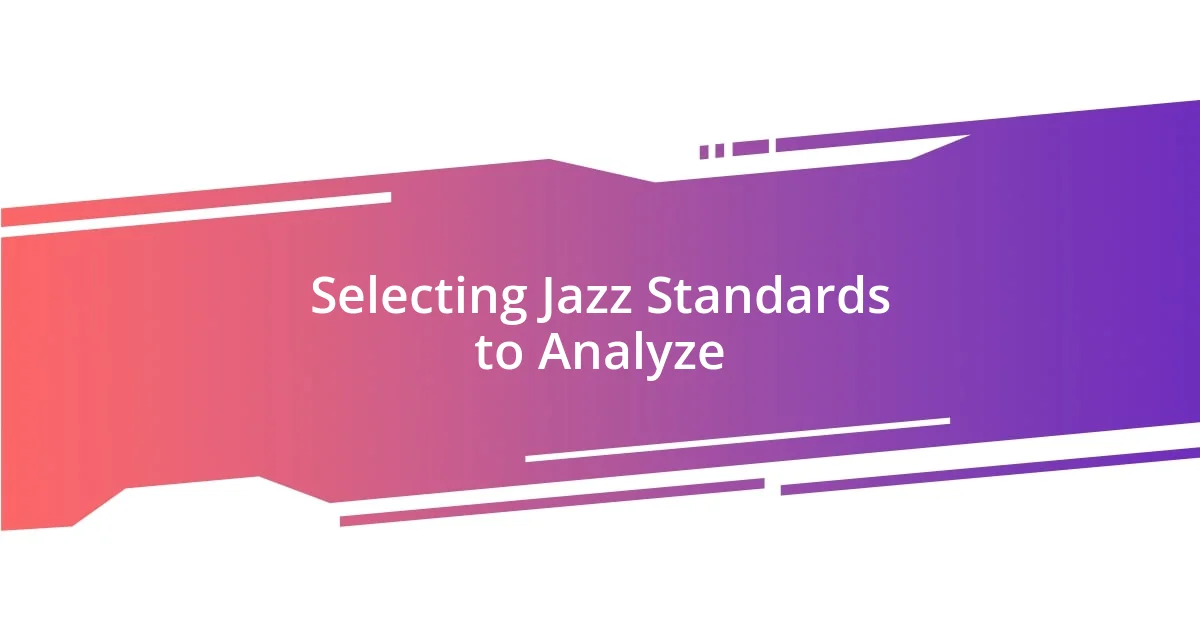
Selecting Jazz Standards to Analyze
When selecting jazz standards to analyze, personal connection plays a huge role for me. I always look for pieces that resonate emotionally, like “Misty.” I recall a rainy afternoon when I first stumbled upon it; the nuances in the melody mirrored my mood perfectly. It’s this kind of emotional tether that makes analysis feel more meaningful and engaging.
In addition to emotional significance, I often prioritize standards that offer rich harmonic structures. Take “Giant Steps,” for instance. The complex chord progressions can feel a bit daunting at first. However, every time I dive into analyzing it, I uncover new layers and insights that challenge my playing and broaden my understanding of harmony. Isn’t it amazing how even a single standard can keep you coming back for more?
Lastly, I make a point to explore standards that have been interpreted by diverse artists across genres. For example, “Take Five” has been performed everything from jazz to pop. This variety adds depth to my analysis, as I can see how different interpretations bring out unique aspects of the piece. It’s like peeling back the layers of an onion, revealing surprises all along the way.
| Criteria | Reason for Selection |
|---|---|
| Emotional Connection | Engages personally, enhancing analysis |
| Harmonic Complexity | Offers deeper musical insights and challenges |
| Diverse Interpretations | Reveals various artistic perspectives and styles |
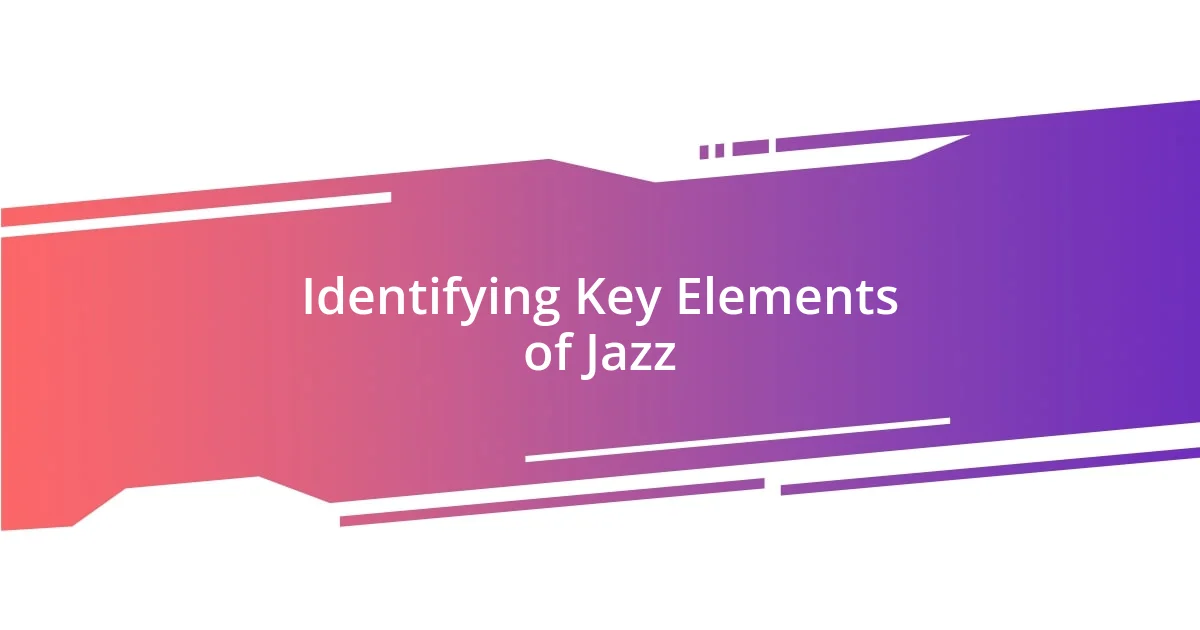
Identifying Key Elements of Jazz
Identifying the key elements of jazz can often feel like embarking on an adventurous journey. I’ve found that listening for rhythm, harmony, melody, and improvisation helps me appreciate the layers at play. Each jazz piece can offer a fusion of these elements, but it’s in the subtle details where the real beauty often lies. For instance, when I first listened to “So What,” I was struck by how the modal approach coupled with a steady rhythm created a space for each musician to shine. Those phrases felt like conversations, weaving together distinct voices into a cohesive tapestry.
Key elements to listen for when analyzing jazz include:
- Rhythm: The driving force that adds energy, often shifting unexpectedly.
- Harmony: Complex chords that create emotional depth and can evoke a range of feelings.
- Melody: The memorable thematic lines that serve as anchors amid the improvisation.
- Improvisation: The spontaneous expression that allows musicians to add their unique touch to a standard.
I’ve always viewed improvisation as one of the most thrilling aspects of jazz. It reminds me of the time I was jamming with friends at an open mic night. As we moved into the solo sections, each musician took a different road—some soaring high, while others embraced a bluesy feel. It’s this unpredictability that gives jazz its heartbeat, and understanding these key elements enhances the way we appreciate and connect with the music.
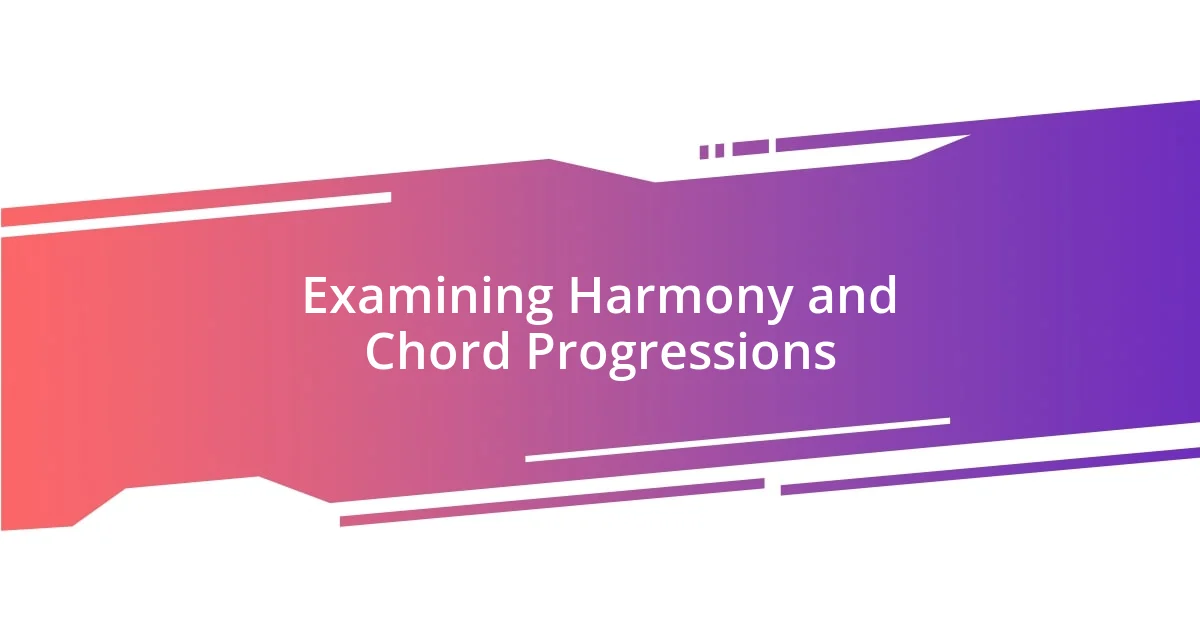
Examining Harmony and Chord Progressions
When I dive into the harmony of a jazz standard, I pay close attention to the chord progressions. For example, while analyzing “Autumn Leaves,” I found that the movement from minor to major chords creates a bittersweet emotional landscape that resonates deeply with me. It almost feels like a journey through different moods, doesn’t it? I often wonder how these changes affect the improvisation that follows.
Chord progressions hold power; they can guide the listener’s emotions in a way that nothing else can. In “Blue Bossa,” the mix of bossa nova rhythm and jazzy harmonies fosters a sense of calm while also inviting exploration. I clearly remember the first time I played this piece—it was during a cozy gathering with friends, and the music seemed to linger in the air, drawing everyone into its soothing embrace. Every chord change felt like a gentle prompt, inviting us to share in the experience.
Exploring extended chords and substitutions also offers fascinating insights into a standard’s character. I enjoy unraveling the intricacies behind “All the Things You Are.” The way it uses intricate chords allows for such rich improvisational possibilities. Isn’t it exhilarating to find new paths to navigate through the music? Each analysis reaffirms my belief that the harmony in jazz serves as a foundational canvas upon which artists can uniquely express themselves.

Analyzing Melodic Structures
When I analyze the melodic structures of jazz standards, I’m often drawn to the way a melody weaves through the harmony and rhythm. For instance, listening to “Round Midnight” reveals a hauntingly beautiful line that seems to dance effortlessly over the chords. I remember sitting with my saxophone, attempting to capture that same ethereal quality. It was a challenge, but understanding the nuances helped me appreciate how each note is selected not just for its sound, but for the emotional weight it carries.
In jazz, melodies can shift in mood and shape, creating dynamic responses from the listener. Take “Take Five,” for example; the melodic line here plays with unconventional time signatures, which adds an exciting twist. When I first played it, I was struck by how the melody felt both playful and sophisticated. It made me wonder how much of an impact these rhythmic variations have on the overall feel of a piece. Do those unexpected turns create more engaging moments for you too?
As I dissect a piece further, I often find pivotal moments where the melody intersects with improvisation. The way that artists such as Miles Davis or John Coltrane interpret a repetitive theme can inspire new layers of meaning. While jamming with a group, I found that adopting a simple melodic phrase led to a beautiful tapestry of ideas—each musician adding their flavor, as if telling their story. Isn’t it captivating to think about how a single melodic structure can evolve into a whole universe of sound?
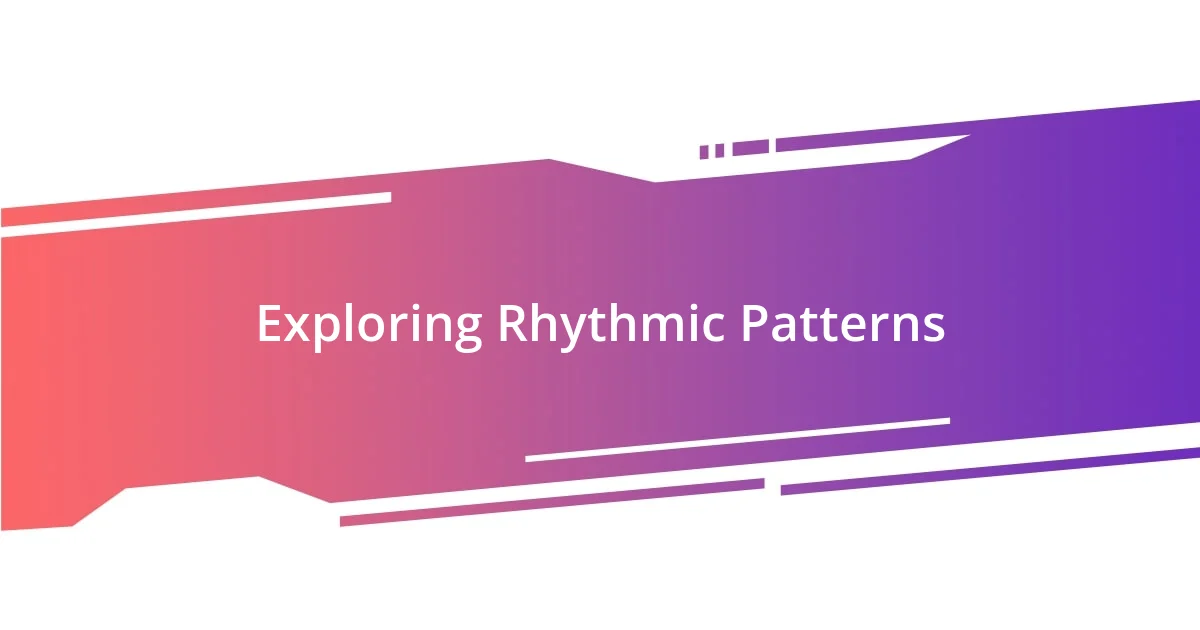
Exploring Rhythmic Patterns
Rhythm is the heartbeat of jazz, and I find it fascinating to explore how rhythmic patterns create distinct grooves in a standard. Take “So What” as an example; its laid-back, syncopated feel sets the stage for improvisation that ebbs and flows. I can vividly remember listening to this track late at night, feeling the urge to snap my fingers along with the bass line—it just pulls you in.
A common practice is to break down the rhythm into smaller components, examining how accents and rests are placed. For instance, when analyzing “Take the ‘A’ Train,” I notice how the rhythm shifts between driving forward and moments that pull back, almost like a conversation between instruments. Each time I revisit this piece, I can’t help but think: how does this interplay between tension and release enhance the listener’s experience?
In my own playing, I strive to internalize these rhythmic nuances. During a recent jam session, I experimented with shifting my phrasing to create a more unpredictable rhythmic foundation. The surprise in my bandmates’ faces when I introduced unexpected syncopation was priceless! This experience reinforces my belief that the exploration of rhythmic patterns is not just an analytical exercise—it’s an invitation to stretch our creative boundaries and connect more profoundly with one another through music.

Applying Analysis to Performance
When I apply my analysis to performance, I often think about how understanding the harmonic changes can fuel my improvisation. I remember playing “Autumn Leaves” at an open mic, feeling a surge of creativity as I navigated through the chord changes. It struck me how each shift in harmony invited a new emotional trajectory—transforming the familiar into something unexpectedly fresh. Don’t you find it exhilarating when you tap into that well of inspiration mid-performance?
As I embrace the nuances of tempo and dynamics, I realize they significantly shape my expressive capability. One evening, while rehearsing “Blue Bossa,” I decided to play around with tempo, gradually swelling in excitement during the bridge. The response from my fellow musicians was electric, as if we were all riding the wave together. Isn’t it amazing how subtle changes can amplify not just our sound, but the connection with the audience too?
Every time I perform, I see it as a living embodiment of my analytical insights. The other day, while tackling “A Night in Tunisia,” I noticed how my understanding of syncopation allowed me to create tension with my solo, before resolving it beautifully over a climactic finish. This interplay between analysis and execution is what creates magic on stage; it’s like painting with sound. Have you noticed how these moments of insight can lead to the most memorable performances?















